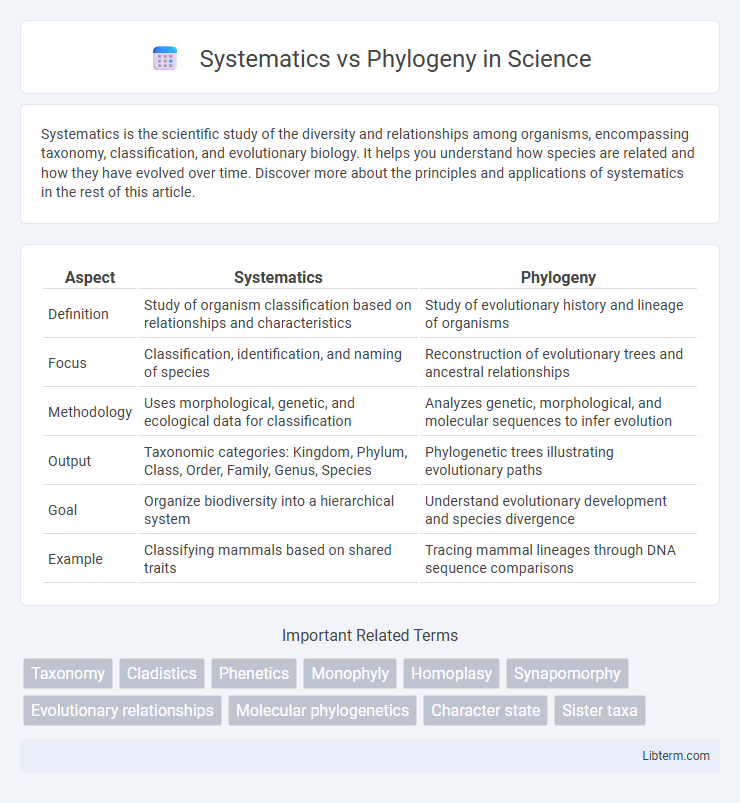Systematics is the scientific study of the diversity and relationships among organisms, encompassing taxonomy, classification, and evolutionary biology. It helps you understand how species are related and how they have evolved over time. Discover more about the principles and applications of systematics in the rest of this article.
Table of Comparison
| Aspect | Systematics | Phylogeny |
|---|---|---|
| Definition | Study of organism classification based on relationships and characteristics | Study of evolutionary history and lineage of organisms |
| Focus | Classification, identification, and naming of species | Reconstruction of evolutionary trees and ancestral relationships |
| Methodology | Uses morphological, genetic, and ecological data for classification | Analyzes genetic, morphological, and molecular sequences to infer evolution |
| Output | Taxonomic categories: Kingdom, Phylum, Class, Order, Family, Genus, Species | Phylogenetic trees illustrating evolutionary paths |
| Goal | Organize biodiversity into a hierarchical system | Understand evolutionary development and species divergence |
| Example | Classifying mammals based on shared traits | Tracing mammal lineages through DNA sequence comparisons |
Introduction to Systematics and Phylogeny
Systematics encompasses the classification and naming of organisms based on evolutionary relationships, integrating taxonomy with phylogenetic analysis to reflect shared ancestry. Phylogeny specifically refers to the evolutionary history and lineage diversification of species, often depicted through phylogenetic trees that illustrate ancestral connections. Understanding systematics provides the framework for organizing biodiversity, while phylogeny reveals the evolutionary pathways that shape the tree of life.
Defining Systematics: Scope and Importance
Systematics encompasses the classification, identification, and naming of organisms, integrating morphological, genetic, and ecological data to understand biodiversity. It establishes evolutionary relationships by analyzing phylogenetic trees, which depict lineage divergence and common ancestry. The importance of systematics lies in its role in organizing biological information, supporting conservation efforts, and enhancing biological research across taxonomy, ecology, and evolutionary biology.
Understanding Phylogeny: Evolutionary Relationships
Understanding phylogeny involves analyzing evolutionary relationships by reconstructing the ancestral lineage of organisms through shared characteristics and genetic data. Unlike systematics, which classifies organisms based on overall similarity, phylogeny emphasizes common descent and evolutionary history to depict branching patterns in a phylogenetic tree. Molecular sequencing and comparative genomics provide crucial insights into these relationships, enabling accurate mapping of divergence times and evolutionary events.
Historical Perspectives: Systematics vs Phylogeny
Historical perspectives on systematics and phylogeny reveal their intertwined development in understanding biological diversity. Systematics traditionally emphasized classifying organisms based on morphological traits and overall similarity, while phylogeny focused on reconstructing evolutionary relationships through common ancestry. Advances in molecular data and cladistics have shifted both fields toward integrating genetic information to resolve evolutionary histories with greater accuracy.
Key Methods in Systematics
Systematics employs key methods such as morphological analysis, molecular sequencing, and computational phylogenetics to classify organisms based on evolutionary relationships. Cladistics, a primary technique, constructs phylogenetic trees using shared derived characters to infer lineage divergence. Molecular markers like DNA barcoding and genome sequencing enhance systematics by providing precise genetic data for resolving taxonomic hierarchies.
Molecular Approaches in Phylogenetic Analysis
Molecular approaches in phylogenetic analysis utilize DNA, RNA, and protein sequences to infer evolutionary relationships, offering higher resolution compared to traditional systematics based on morphological traits. Techniques such as gene sequencing, molecular clocks, and comparative genomics enable precise reconstruction of phylogenetic trees, reflecting genetic divergence and speciation events. These methods enhance understanding of evolutionary history by providing quantifiable molecular data, which resolves ambiguities inherent in phenotypic classification systems.
Comparative Analysis: Systematics and Phylogeny
Systematics involves the classification and naming of organisms based on shared characteristics, while phylogeny reconstructs their evolutionary relationships using genetic, morphological, and molecular data. Comparative analysis in systematics examines phenotypic traits to organize species into taxonomic hierarchies, whereas phylogenetic studies employ cladistics and molecular sequences to infer common ancestry and evolutionary divergence. Integrating systematics with phylogenetic frameworks enhances biodiversity understanding by aligning classification with evolutionary history.
Applications in Modern Biological Research
Systematics provides a comprehensive framework for classifying organisms based on evolutionary relationships, aiding in biodiversity assessment and conservation strategies. Phylogeny applies molecular data to reconstruct evolutionary histories, enhancing the accuracy of species identification and tracking genetic traits across populations. Modern biological research leverages both systematics and phylogeny to improve drug discovery, ecosystem management, and understanding of disease transmission pathways.
Challenges and Limitations in Classification
Systematics faces challenges in classification due to incomplete fossil records and morphological convergence, which complicate the accurate grouping of organisms. Phylogeny struggles with limited genetic data and horizontal gene transfer, resulting in conflicting evolutionary trees. Both approaches encounter limitations from ongoing discoveries that constantly reshape the understanding of species relationships and lineages.
Future Trends in Systematics and Phylogenetic Studies
Future trends in systematics and phylogenetic studies emphasize integrating high-throughput genomic sequencing and advanced bioinformatics tools to resolve complex evolutionary relationships. Machine learning algorithms and improved computational models enhance the accuracy of phylogenetic tree reconstructions, facilitating real-time analysis of large datasets. The synergy of molecular data, fossil records, and ecological information promises more comprehensive and predictive frameworks for biodiversity classification and evolutionary history.
Systematics Infographic

 libterm.com
libterm.com